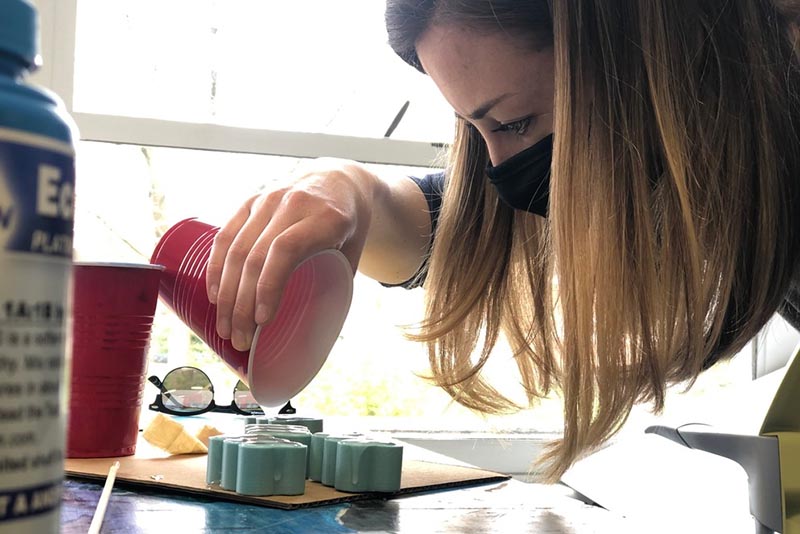
Jessica Menold, assistant professor of engineering design, pours silicone into molds to create earpieces for disposable stethoscopes. IMAGE: JESSICA MENOLD
Single-patient stethoscopes show heartbeat of Penn State's COVID-19 response
Engineering professor prototypes 3D-printed design, within the University-wide Manufacturing and Sterilization for COVID-19 (MASC) Initiative, to address an urgent need for Penn State Health
7/7/2020
By Erin Cassidy Hendrick
UNIVERSITY PARK, Pa. — In close collaboration with Penn State Health and the Center for Medical Innovation at Penn State College of Medicine, Penn State College of Engineering faculty and students organized to design and deliver disposable stethoscopes to help equip front-line health care workers battling the COVID-19 pandemic.
Jessica Menold, assistant professor of engineering design and mechanical engineering, has been a key member of the University-wide Manufacturing and Sterilization for COVID-19 (MASC) Initiative, a consortium of more than 350 researchers aiming to utilize their expertise and resources to create and implement rapidly scalable solutions, particularly to positively impact Pennsylvania communities.
Stethoscopes, which are routinely needed for essential medical examinations, presented an unexpected, new challenge for the MASC team. Because of additional COVID-19 precautions, physicians at the Hershey Medical Center indicated a need for a disposable, single-patient stethoscope.
Only days later, Menold launched a mini-hackathon in her lab group, the Technology and Human Research in Engineering Design lab, and a team of graduate students including Tobias Mahan, Daniel Spillaine, Lauren Ryan, Glen Williams and Pratima Saravanan, had a viable design.
For the initial design, Menold, Sarah Ritter, associate teaching professor of engineering design, Andrea Arguelles, assistant professor of engineering science and mechanics, Caitlin Grady, assistant professor of civil engineering, and Meg Handley, associate director of engineering leadership outreach, created a new stethoscope with silicone food-grade tubing, typically used to make beer; hand-made silicone earpieces made via a 3D printed mold; automotive brake line, and a 3D-printed cover and diaphragm.
The professors worked in the evenings and on the weekends with support from Bill Genet and Robert McAllister, shop supervisors at the Learning Factory, to produce 100 stethoscopes that were delivered to Penn State Health Milton S. Hershey Medical Center for testing.
“When Dr. Menold asked if we were available to help, not one of us hesitated. While it was a considerable effort, it was empowering to know that in some small way we were helping medical workers on the front line,” said Arguelles.
With rapid feedback from a team of physicians and medical students, led by Dr. Anthony Tsai, a physician at the Milton S. Hershey Medical Center, the design evolved significantly over the next two weeks to improve acoustic quality while reducing the number of parts and assembly time. Menold, Arguelles and Ritter worked as a sub-team to reduce the manufacturing time and cost of the stethoscopes, making them easier to produce at a larger scale.
Ritter said, “Working as a smaller team with such varied expertise and background really helped us to think outside the box and develop a simple, yet effective, solution.”
Several dozen prototypes were sent to the Hershey Medical Center and Barry Fell, a consultant for the Department of Surgery at the Hershey Medical Center and a member of the MASC team, is now moving forward toward the mass production of a final stethoscope. Fell is working with industry partners to finalize a manufacturable design that can be mass produced in a GMP facility to address the urgent need.
With their goal of providing Penn State Health with these critical pieces of equipment on the horizon, Menold said she is inspired by the collaborative spirit she has witnessed in both the College of Engineering and the Hershey Medical Center.
“As someone who studies engineering design, I’m fascinated with the pace of the design processes needed to produce critical medical products for this crisis,” she said. “The near-constant communication between MASC and the medical center is a real catalyst for engineering design innovation.”
If you would like to support Penn State’s response to the novel coronavirus pandemic, visit http://c-fund.us/rhc.
“We Are” stories
The “We Are” spirit is perhaps more important than ever before, and Penn Staters everywhere are coming together in new and amazing ways. During these challenging times, our community is continuing to realize Penn State’s commitment to excellence through acts of collaboration, thoughtfulness and kindness. As President Eric Barron has written on Digging Deeper, this truly is a “We Are” moment.



